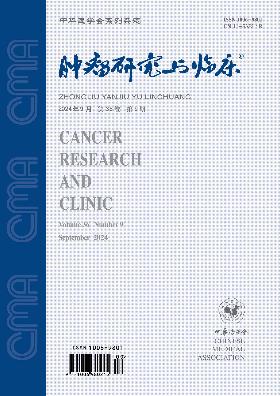Expressions of coordinated stimulating molecular programmed death 1 and its ligand 1 in brain glioma and their clinical significances
Q4 Medicine
引用次数: 0
Abstract
Objective To analyze the expressions of coordinated stimulating molecular programmed death 1(PD-1) and programmed death ligand 1 (PD-L1) in human glioma and their clinical significances. Methods A total of 70 postoperative paraffin specimens of brain glioma and 35 normal brain tissues in Heji Hospital Affiliated to Changzhi Medical College from January 2013 to December 2017 were collected. The expressions of PD-1 and PD-L1 in 70 glioma tissues and 35 normal brain tissues were detected by immunohistochemical SP method. The relationship between the expressions of PD-1 and PD-L1 and their correlation with the clinicopathological features were analyzed. Results The positive expression rates of PD-1 and PD-L1 in glioma tissues were 69% (48/70) and 62% (43/70), respectively, which were higher than those in normal brain tissues [29% (10/35), 31% (11/35)], the differences were statistically significant (χ2 values were 15.099 and 8.407, both P 0.05). There was a positive correlation between the expressions of PD-1 and PD-L1 proteins in glioma tissues (r= 0.372, P= 0.002). Conclusions The PD-1 and PD-L1 may become new biological indicators for evaluating the occurrence and development of glioma. Key words: Brain neoplasms; Glioma; Programmed death 1; Programmed death ligand 1; Immunohistochemistry协同刺激分子程序性死亡1及其配体1在脑胶质瘤中的表达及其临床意义
目的分析协同刺激分子程序性死亡1(PD-1)和程序性死亡配体1(PD-L1)在人脑胶质瘤中的表达及其临床意义。方法收集长治医学院附属何济医院2013年1月至2017年12月的70例脑胶质瘤术后石蜡标本和35例正常脑组织标本。用免疫组化SP法检测了70例胶质瘤组织和35例正常脑组织中PD-1和PD-L1的表达。分析PD-1和PD-L1的表达与临床病理特征的关系。结果PD-1和PD-L1在胶质瘤组织中的阳性表达率分别为69%(48/70)和62%(43/70),高于正常脑组织[29%(10/35)、31%(11/35)],两者差异有统计学意义(χ2分别为15.099和8.407,均P<0.05)。胶质瘤组织中PD-1和PD-L1蛋白的表达呈正相关(r=0.372,P=0.002)。关键词:脑肿瘤;胶质瘤;程序性死亡1;程序性死亡配体1;免疫组织化学
本文章由计算机程序翻译,如有差异,请以英文原文为准。
求助全文
约1分钟内获得全文
求助全文
来源期刊

肿瘤研究与临床
Medicine-Oncology
CiteScore
0.10
自引率
0.00%
发文量
7737
期刊介绍:
"Cancer Research and Clinic" is a series of magazines of the Chinese Medical Association under the supervision of the National Health Commission and sponsored by the Chinese Medical Association.
It mainly reflects scientific research results and academic trends in the field of malignant tumors. The main columns include monographs, guidelines and consensus, standards and norms, treatises, short treatises, survey reports, reviews, clinical pathology (case) discussions, case reports, etc. The readers are middle- and senior-level medical staff engaged in basic research and clinical work on malignant tumors.
 求助内容:
求助内容: 应助结果提醒方式:
应助结果提醒方式:


